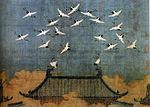- Mid-Imperial China
-
History of China Mid-ImperialRelated topics
Mid-Imperial China begins with the reunification of China by the short-lived Sui dynasty in 589. The Sui replaced the nine-rank system with the imperial examination and embarked on major public works such as connecting the various canals to form the Grand Canal. They also replaced the state structure with the Three Departments and Six Ministries, a system that would remain little changed until the adoption of a cabinet in May 1911 just prior to the Xinhai Revolution.After the Sui were overthrown, the Tang dynasty ruled for three centuries in prosperity. Its collapse was followed by decades of upheaval known as the Five Dynasties and Ten Kingdoms Period. Tribes from the north took advantage of the disunity to set up the Northern Conquest Dynasties. Most of China proper was reunified by the Song dynasty in 960 which saw major technological, economic, and cultural advances and the rise of neo-Confucianism. China was conquered by the Mongol Empire in 1279. The period spanning the Tang and Song dynasties is also known as the Golden Age of China.
See also
- Early Imperial China
- Late Imperial China
- Middle Chinese
- History of China
- Chinese historiography
Categories:- History of Imperial China
- Chinese history stubs
Wikimedia Foundation. 2010.

